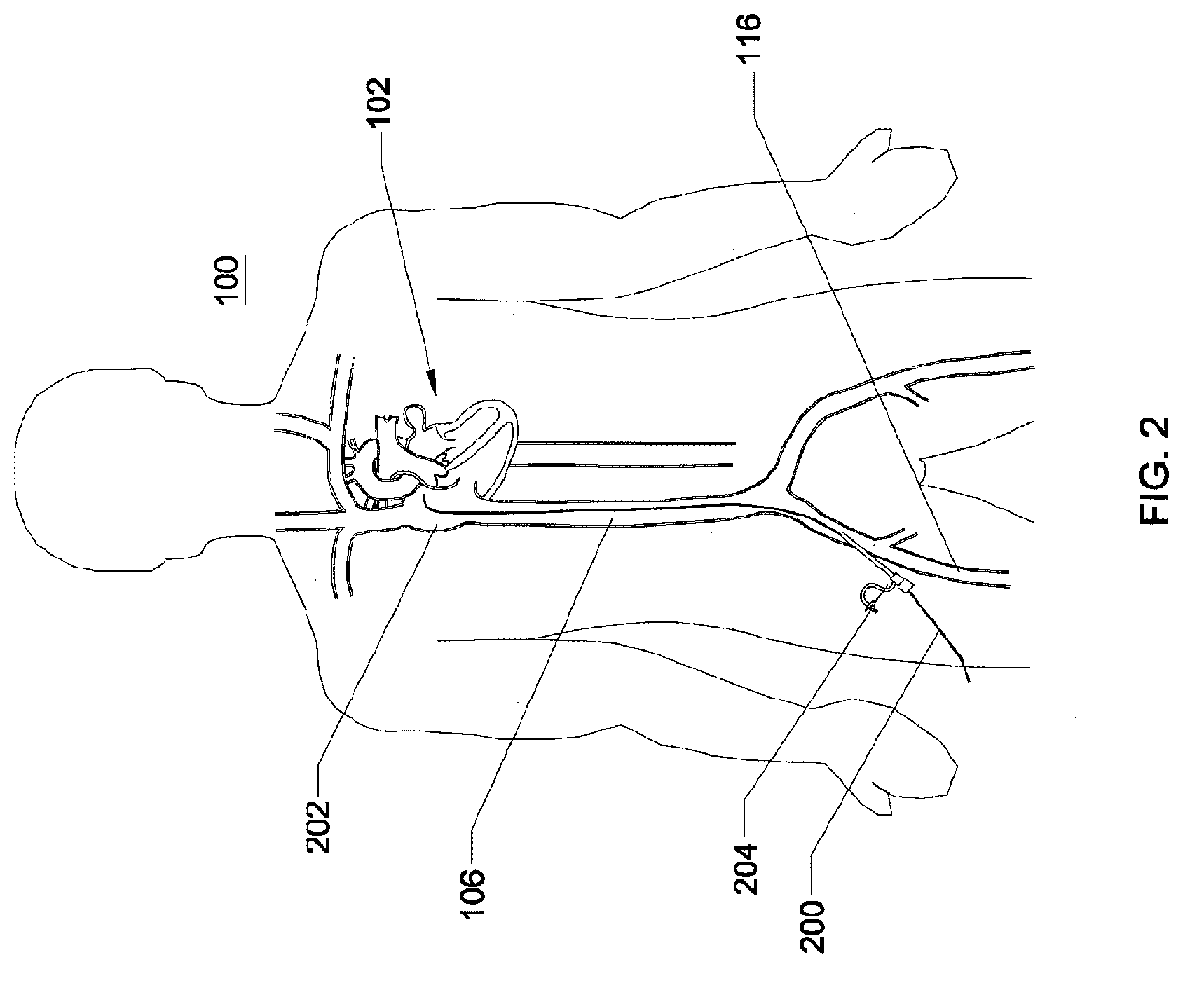[0013]A transluminal, radially expanding access sheath is provided according to an embodiment of the present invention. In an embodiment, the radially expanding access sheath is used to provide access to the
left atrium by way of a trans-septal puncture and advancement in the atrial septum dividing the right and left atriums. In an embodiment, the sheath can have an introduction outside
diameter that ranges from 3 to 12 French with a preferred range of 5 to 10 French. The
diameter of the sheath can be expandable to permit instruments
ranging up to 30 French to pass therethrough, with a preferred range of between 3 and 20 French. The sheath can have a working length
ranging between 40-cm and 200-cm with a preferred length of 75-cm to 150-cm. The ability to pass the traditional
electrophysiology therapeutic and diagnostic catheters and instruments as well as larger, more innovative, instruments through a
catheter introduced with a small outside
diameter is derived from the ability to atraumatically expand the distal end of the catheter or sheath to create a larger through lumen to access the cardiac chambers. The ability to pass multiple catheters through a single sheath with a single septal penetration is inherently
safer and less time-consuming than a multiple septal
puncture procedure. The expandable distal end of the catheter can comprise between 5% and 95% of the overall working length of the catheter. The proximal end of the catheter is generally larger than the distal end to provide for pushability, torqueaqbility (preferably approximately 1:1 torqueability), steerability, control, and the ability to easily pass large diameter instruments therethrough. In an embodiment, the sheath can be routed to its destination over one or more already placed guidewires with a diameter
ranging from 0.010 inches up to 0.040 inches and generally approximating 0.035 to 0.038 inches in diameter. An
advantage of approaching the treatment site by the veins, instead of the arteries, is that the
venous pressure is lower than that in the arterial
system, thus reducing the potential for catastrophic hemorrhage during the procedure. Another
advantage of the system is that the sheath and
dilator assembly are flexible enough to track over a guidewire and be steered by either the guidewire or by a Brockenbrough needle, inserted through the central lumen of the
dilator.
[0014]One embodiment of the invention comprises an endovascular access system for providing minimally invasive access to atrial structures of the
mammalian heart. The system includes an access sheath comprising an axially elongate tubular body that defines a lumen extending from the proximal end to the distal end of the sheath. At least a portion of the distal end of the elongate tubular body is radially expandable from a first, smaller cross-sectional profile to a second, greater cross-sectional profile. In an embodiment, the first, smaller cross-sectional profile is created by making axially oriented folds in the sheath material. These folds may be located in only one circumferential position on the sheath, or there may be a plurality of such folds or longitudinally oriented crimps in the sheath. The folds or crimps may be made permanent or semi-permanent by heat-setting the structure, once folded. In an embodiment, a releasable or expandable jacket is carried by the access sheath to restrain at least a portion of the elongate tubular structure in the first, smaller cross-sectional profile during
insertion and up to or during inflation of the distal region. In another embodiment, the jacket is removed prior to inserting the sheath into the patient. In an embodiment, the elongate tubular body is sufficiently w pliable to allow the passage of objects having a maximum cross-sectional size larger than an inner diameter of the elongate tubular body in the second, greater cross-sectional profile. The adaptability to objects of larger dimension is accomplished by
pliability or re-shaping of the cross-section to the larger dimension in one direction accompanied by a reduction in dimension in a lateral direction. The adaptability may also be generated through the use of malleable or elastomerically deformable sheath material. This re-shaping or non-round cross-section can be beneficial in passing two or more catheters through a single sheath with a minimum lateral cross-sectional area.
[0015]In another embodiment of the invention, a transluminal access sheath
assembly for providing minimally invasive access comprises an elongate tubular member having a proximal end and a distal end and defining a working inner lumen. In this embodiment, the tubular member comprises a folded or creased sheath that can be expanded by a dilatation
balloon. The dilatation
balloon, if filled with fluids, preferably liquids and further preferably radiopaque liquids, at appropriate pressure, can generate the force to radially dilate or expand the sheath. The dilatation
balloon is removable to permit subsequent instrument passage through the sheath. Longitudinal runners may be disposed within the sheath to serve as tracks for
instrumentation, which further minimize friction while minimizing the risk of catching the instrument on the expandable plastic tubular member. Such longitudinal runners are preferably circumferentially affixed within the sheath so as not to shift out of alignment. In yet another embodiment, the longitudinal runners may be replaced by longitudinally oriented ridges and valleys, termed flutes. The flutes, or runners, can be oriented along the longitudinal axis of the sheath, or they can be oriented in a spiral, or rifled, fashion.
 Login to View More
Login to View More 


